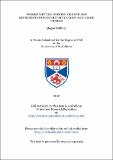Files in this item
Women writing women : gender and representation in British 'Golden Age' crime fiction
Item metadata
| dc.contributor.advisor | Plain, Gill | |
| dc.contributor.author | Hoffman, Megan | |
| dc.coverage.spatial | 231 p. | en_US |
| dc.date.accessioned | 2017-10-24T12:58:27Z | |
| dc.date.available | 2017-10-24T12:58:27Z | |
| dc.date.issued | 2012-11 | |
| dc.identifier.uri | https://hdl.handle.net/10023/11910 | |
| dc.description.abstract | In this thesis, I examine representations of women and gender in British ‘Golden Age’ crime fiction by writers including Margery Allingham, Christianna Brand, Agatha Christie, Ngaio Marsh, Dorothy L. Sayers, Josephine Tey and Patricia Wentworth. I argue that portrayals of women in these narratives are ambivalent, both advocating a modern, active model of femininity, while also displaying with their resolutions an emphasis on domesticity and on maintaining a heteronormative order, and that this ambivalence provides a means to deal with anxieties about women’s place in society. This thesis is divided thematically, beginning with a chapter on historical context which provides an overview of the period’s key social tensions. Chapter II explores depictions of women who do not conform to the heteronormative order, such as spinsters, lesbians and ‘fallen’ women. Chapter III looks at the ways in which the courtships and marriages of detective couples attempt to negotiate the ideal of companionate marriage and the pressures of a ‘cult of domesticity’. Chapter IV considers the ways in which depictions of women in schools, universities and the workplace are used to explore the tensions between an expanding role in the public sphere and the demand to inhabit traditionally domestic roles. The thesis concludes with a discussion of the image of female victims’ and female killers’ bodies and the ways in which such depictions can be seen to expose issues of gender, class and identity. Through its examination of a wide variety of texts and writers in the period 1920 to the late 1940s, this thesis investigates the ambivalent nature of modes of femininity depicted in Golden Age crime fiction written by women, and argues that seemingly conservative resolutions are often attempts to provide a ‘modern-yet-safe’ solution to the conflicts raised in the texts. | en_US |
| dc.language.iso | en | en_US |
| dc.publisher | University of St Andrews | |
| dc.subject.lcc | PR119.H74 | |
| dc.subject.lcsh | Detective and mystery stories, English--Women authors--History and criticism. | en |
| dc.subject.lcsh | Women and literature--Great Britain--History--20th century. | en |
| dc.subject.lcsh | Crime in literature. | en |
| dc.subject.lcsh | Femininity in literature. | en |
| dc.title | Women writing women : gender and representation in British 'Golden Age' crime fiction | en_US |
| dc.type | Thesis | en_US |
| dc.type.qualificationlevel | Doctoral | en_US |
| dc.type.qualificationname | PhD Doctor of Philosophy | en_US |
| dc.publisher.institution | The University of St Andrews | en_US |
This item appears in the following Collection(s)
Items in the St Andrews Research Repository are protected by copyright, with all rights reserved, unless otherwise indicated.

